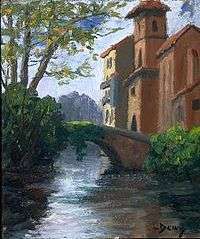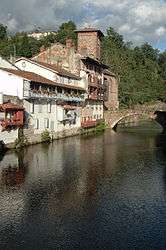Saint-Jean-Pied-de-Port
| Saint-Jean-Pied-de-Port | ||
|---|---|---|
|
Old bridge over river Nive | ||
| ||
 Saint-Jean-Pied-de-Port | ||
|
Location within Nouvelle-Aquitaine region  Saint-Jean-Pied-de-Port | ||
| Coordinates: 43°09′54″N 1°14′08″W / 43.165°N 1.2356°WCoordinates: 43°09′54″N 1°14′08″W / 43.165°N 1.2356°W | ||
| Country | France | |
| Region | Nouvelle-Aquitaine | |
| Department | Pyrénées-Atlantiques | |
| Arrondissement | Bayonne | |
| Canton | Saint-Jean-Pied-de-Port | |
| Intercommunality | Garazi-Baïgorri | |
| Government | ||
| • Mayor (2001–2008) | Alphonse Idiart | |
| Area1 | 2.73 km2 (1.05 sq mi) | |
| Population (2006)2 | 1,754 | |
| • Density | 640/km2 (1,700/sq mi) | |
| Time zone | CET (UTC+1) | |
| • Summer (DST) | CEST (UTC+2) | |
| INSEE/Postal code | 64485 / 64220 | |
| Elevation |
159–320 m (522–1,050 ft) (avg. 180 m or 590 ft) | |
|
1 French Land Register data, which excludes lakes, ponds, glaciers > 1 km² (0.386 sq mi or 247 acres) and river estuaries. 2 Population without double counting: residents of multiple communes (e.g., students and military personnel) only counted once. | ||
Saint-Jean-Pied-de-Port (literally "Saint John [at the] Foot of [the] Pass"; Basque: Donibane Garazi; Spanish: San Juan Pie de Puerto) is a commune in the Pyrénées-Atlantiques department in south-western France close to Ostabat in the Pyrenean foothills. The town is also the old capital of the traditional Basque province of Lower Navarre. This is also a starting point for the Camino Francés, the most popular option for travelling the Camino de Santiago.
Geography
The town lies on the river Nive, 8 km (5.0 mi) from the Spanish border, and it is the head town of the region of Cize (Garazi in Basque). It is made up essentially of one main street with sandstone walls encircling.
Neighboring municipalities
History

by Louis Dewis
The original town at nearby Saint-Jean-le-Vieux was razed to the ground in 1177 by the troops of Richard the Lionheart after a siege. The Kings of Navarre refounded the town on its present site shortly afterwards.
The town was thereafter a town of the Kingdom of Navarre, and the seat of the sheriff of the Lower Navarre district ("merindad" of Ultrapuertos or Deça-Ports). It stack to that category up to the period of the Spanish conquest (1512-1528), when King Henry II of Navarre decided to transfer the seat of the royal institutions to Saint Palais (Donapaleu) on safety grounds.
The town has traditionally been an important point on the Way of St. James, the pilgrimage to Santiago de Compostela, as it stands at the base of the Roncevaux Pass across the Pyrenees. Pied-de-Port means 'foot of the pass' in Pyrenean French. The routes from Paris, Vézelay and Le Puy-en-Velay meet at Saint-Jean-Pied-de-Port and it was the pilgrims' last stop before the arduous mountain crossing.
In 1998, the Porte St-Jacques (city gate) was added to the UNESCO World Heritage Sites as part of the sites along the Routes of Santiago de Compostela in France.
Main sights
The cobbled rue de la Citadelle runs down hill and over the river from the fifteenth century Porte St-Jacques to the Porte d'Espagne by the bridge. From the bridge, there are views of the old houses with balconies overlooking the Nive. Many of the buildings are very old, of pink and grey schist, and retain distinctive features, including inscriptions over their doors. One, a bakery, lists the price of wheat in 1789.

The 14th century red schist Gothic church, Notre-Dame-du-Bout-du-Pont, stands by the Porte d'Espagne. The original was built by Sancho the Strong of Navarre to commemorate the 1212 Battle of Las Navas de Tolosa where Moorish dominance of Spain was undermined.
Above the town at the top of the hill is the citadel, remodelled by Vauban in the 17th century.
Outside the walls is a new town, with the Hôtel de Ville and a pelota fronton.
Economy
Traditional crafts and foods remain in the town, including Basque linen from the Inchauspé family since 1848. The town is now an important tourist centre for the Pyrenees and the French Basque country and there are shops, restaurants and hotels.
St-Jean-Pied-de-Port specializes in fromage de brebis or OssauIraty, sheep's cheese, local trout and pipérade, omelette with peppers and Bayonne ham.
Mondays see a large market, with sheep and cattle driven into the town. At 5pm, there is a communal game of bare-handed pelote at the fronton. There are large fairs four times a year.
Transportation
Saint-Jean-Pied-de-Port is the terminus on the railway line from Bayonne through the French Basque Country, along the valley of the river Nive, with several services each day. It is 1 km from the centre of the town. Biarritz Airport is the closest airport to Saint Jean Pied de Port.
Notable people
- Bernard Etxepare (late 15th - mid 16th century), writer of first printed book in Basque.
- Juan Huarte de San Juan (c. 1530-1592), physician and psychologist was born there.
- Charles Floquet (1828–1896), born in Saint-Jean-Pied-de-Port, French lawyer and statesman.
- Imanol Harinordoquy (born 1980), French international rugby union player, grew up in the town.
See also
References
External links
| Wikimedia Commons has media related to Saint-Jean-Pied-de-Port. |

